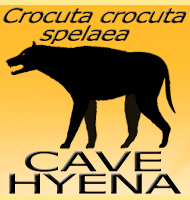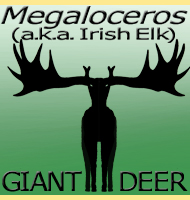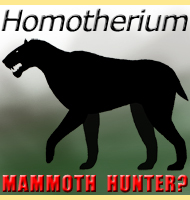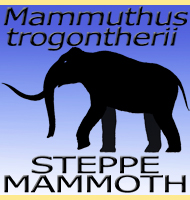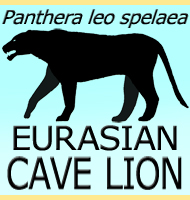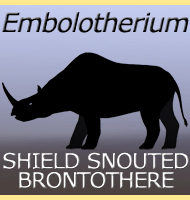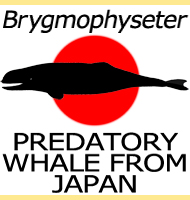


Coelodonta
(Woolly Rhino)
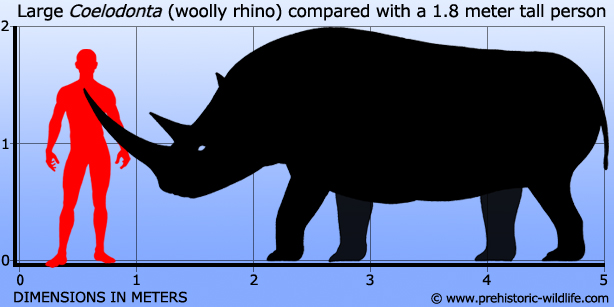
Name:
Coelodonta
(hollow tooth)
Phonetic: See-low-don-tah.
Named By: Bronn - 1831.
Synonyms: Rhinoceros tichorhinus,
Coelodonta boiei.
Classification: Chordata, Mammalia,
Perissodactyla, Rhinocerotidae.
Species: C. antiquitatis
(type),
C. nihowanensis, C. thibetana, C. tologoijensis.
Diet: Herbivore.
Size: 2 meters tall at the shoulder, between
3 to 3.8 meters long. Some specimens may have been slightly
larger.
Known locations: Across Eurasia (Europe,
Russia, Asia).
Time period: Piacenzian of the Pliocene to early
Holocene.
Fossil representation: Multiple specimens,
including animals that have been completely preserved so that the full
body and not just the bones is preserved.
Coelodonta
is one of the most commonly represented ‘ice age’ mammals, yet
surprisingly it often only gets a name mention. Popularly known as
the woolly rhino, Coelodonta resembled the large
rhinos that we know
today from Africa, but with a complete covering of fur over its
body. This was the main survival adaptation of Coelodonta
which
inhabited most of Eurasia for over two and a half million years.
Coelodonta
lived at a time that saw a series of glaciations across the Northern
hemisphere that saw sheets of ice sweeping over much of the land, to
receding back before covering the land again. This toing and froing
of the ice sheets, combined with the colder climate that caused much
of the lower soil depths to be permanently frozen, created vast
expanses of frozen plains that were covered in grasses interspersed
with low growing vegetation, and it is this ecosystem that
Coelodonta seems to have been most adapted to. As
with many similar
herbivores, Coelodonta had sharp incising teeth
at the front of the
mouth and mashing molar teeth at the back. Between these two sets of
teeth was a gap called the diastema, something else that is common
amongst herbivorous mammals.
It’s
uncertain exactly what kind of herbivore Coelodonta
was. Some people
think that Coelodonta was a grazer that cropped the
grass plains like a
cow, while others believe that it was a browser than fed from low
growing plants. Either one is plausible; although most lean towards
the grazing idea as grasses would have been much more abundant than
more complex low growing plants. Coelodonta is
thought to have used a
fermentation method of processing the cellulose rich grasses in order
to get the full nutritional benefit from the nutritionally poor
vegetation of the ecosystem. This is actually a very clever method of
digestion to adopt since as the grass is broken down by fermentation
inside the gut of Coelodonta, it generates a
small amount of heat
that would have the added effect of warming the body from the inside.
This
method of digestion seems to have been very efficient for Coelodonta
as
specimens where the main body is still preserved show that Coelodonta
had a hump that rose up from its back above the shoulder blades. This
hump was supported from within by the forwards dorsal vertebrae that
had elongated neural spines growing from them, much larger the neural
spines of the other vertebrae. This hump would have served as fat
storage so that Coelodonta could build up fat
reserves in the milder
spring and summer so that it could better survive the colder winter
when the plants had begun to die back, and possibly even had a deep
covering of snow and ice.
Efficient
processing of plants that have a low nutritional value is important for
an animal like Coelodonta, but just as important
for survival is
efficient energy use and conservation. As a mammal, Coelodonta
was
certainly warm blooded, which means that the body works to try and
maintain a stable temperature different from it environment (in this
case much higher). Usually this is done by a process of involuntary
muscle actions to generate heat such as the rapid and repeated
constriction of muscle fibres, better known as ‘shivering’. In
the short term shivering is not a problem, but prolonged shivering
results in more calories being burned (used up), and the more
that are burned the more likely that an animal will use up all it has.
With no more calories to use, and not enough coming from the plants
to maintain the level of use, an animal will stop shivering and
quickly succumb to the cold, quite possibly dying from exposure.
As
briefly mentioned above, Coelodonta had a
covering of fur over its
body, something which led to the name ‘woolly rhino’. This was
the main line of defence against the cold, and would have trapped
layers of air near to the skin. With these layers protected from
mixing with the outer air they would be warmed by the body, and
because this layer of inner air did not require any energy to
maintain, it would have been like a blanket that slowed down the rate
of heat loss from the body to the outside environment. A similar
effect to this is simply wearing clothes as these layers of fabric trap
pockets of air against your body to keep you warm. The effect is
especially pronounced for thicker garments such as jumpers which offer
a greater level of insulation. In addition to the fur, the body
proportions of Coelodonta also helped to prevent
heat loss. For
example, the short legs of Coelodonta are a
further adaption to the
cold environment as they would reduce the surface area exposed to the
cold climate, reducing the area for heat loss to take place.
No
description of a rhino would be complete without mentioning the horn
and this goes double for Coelodonta as it had two
pronounced horns
rising from its snout. The front horn at up to two meters long was
the longer of the two, with the second horn rising from the middle of
the snout being just over half to two thirds as big. The classical
explanation for these horns is that they were what are termed
sexually selected characteristics. This is based upon the knowledge
that the horn would have been growing throughout the animals life, no
more than a stump in a juvenile to fully developed in mature
individuals. An older animal would have a more developed horn than
younger individuals signalling to members of the opposite sex that it
had the genetic makeup and success to make it to later life, and was
more deserving of passing its genes down to the next generation than
lesser individuals that had less developed horns. Such reasoning
would explain the progression to larger horn sizes.
However
there is a second theory regarding the front horn that is both an
alternative and possible addition to the above theory. The front horn
is strongly curved so that it extends out beyond the end of the snout.
This horn is also laterally compressed so that when viewed from the
front the horn looks more like a blade rather than a cone like in other
genera. This leads to the popular interpretation the front horn was
not just a display device but an actual tool that Coelodonta
used to
scrape snow off the ground as it moved its head from side to side.
This would expose buried grasses that allowed Coelodonta
to feed
further without using energy to walk to an area that was uncovered,
and would have been of particular use when Coelodonta
was in areas
that had frequent snowfall, but not a permanent covering.
The
earliest remains of Coelodonta are from India and
have been dated back
to the end of the Pliocene period. The majority of other Coelodonta
remains so far known are from Europe and Russia and these date back to
the Calabrian of the Pleistocene, which suggests that Coelodonta
first emerged in central Asia and then expanded its range. This
expansion could have been synchronised to the availability of
tundra-like environments that were constantly changed from the varying
expansion and receding of the ice sheets that once covered the northern
hemisphere.
One
of the best examples of Coelodonta comes from a
Tar Pit in Poland
(near Starunia) that had its body frozen and preserved. Before
this time the only visual representation of the living Coelodonta
was
in the form of cave art that had been made by ancient human beings.
Further reading
-Nuevas aportaciones al conocimiento de Coelodonta
antiquitatis
(Blumenbach, 1799) de Brown Bank, Mar del Norte [New contributions to
the knowledge of Coelodonta antiquitatis
(Blumenbach, 1799) Brown Bank,
North Sea] - Bulletin Centre d'Est. Natura B-N. VII 13): 309-329 Sta.
Coloma de Gramenet - David Garcia Fern�ndez & Juan Vicente i
Castells - 2008.
- Out of Tibet: Pliocene Woolly Rhino Suggests High-Plateau Origin of
Ice Age Megaherbivores. - Science 333 (6047): 1285–1288 - T. Deng, X.
Wang, M. Fortelius, Q. Li, Y. Wang, Z. J. Tseng, G. T. Takeuchi, J. E.
Saylor, L. K. S�il� & G. Xie - 2011.
Random favourites
 |
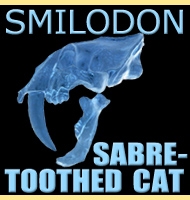 |
 |
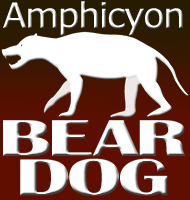 |

